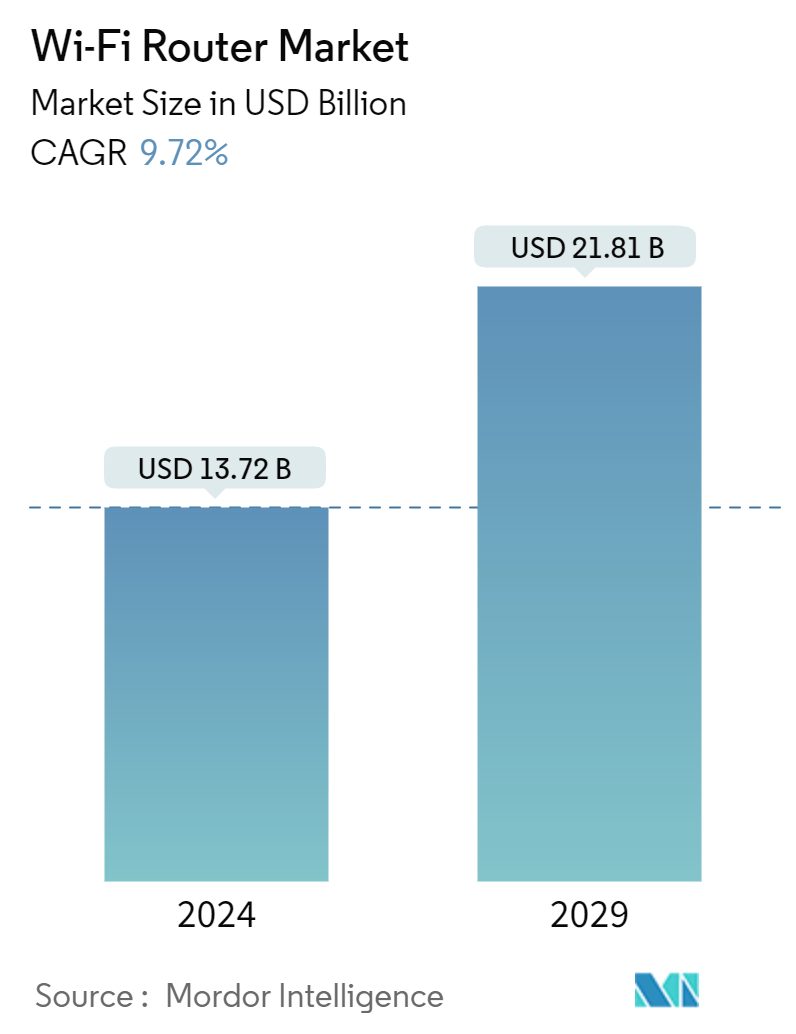Market Size of Wi-Fi Router Industry

| Study Period | 2019 - 2029 |
| Market Size (2024) | USD 13.72 Billion |
| Market Size (2029) | USD 21.81 Billion |
| CAGR (2024 - 2029) | 9.72 % |
| Fastest Growing Market | Asia Pacific |
| Largest Market | North America |
| Market Concentration | Medium |
Major Players
*Disclaimer: Major Players sorted in no particular order |
Wi-Fi Router Market Analysis
The Wi-Fi Router Market size is estimated at USD 13.72 billion in 2024, and is expected to reach USD 21.81 billion by 2029, growing at a CAGR of 9.72% during the forecast period (2024-2029).
A growing number of customers are engaging in web browsing, mobile learning, and other online-related activities, driving the demand for faster Internet access. As a result, the wireless router, frequently utilized in laptops, PCs, and tablets, has become essential for human existence. Wireless routers are primarily responsible for the rising need among consumers to stay linked to dependable Internet and for enhancing internet connections in numerous nations.
- A growing number of customers are engaging in e-commerce transactions, web browsing, mobile learning, and other online-related activities, driving the demand for faster Internet access. As a result, the wireless router, frequently utilized in laptops, PCs, and tablets, has become essential for human existence. Wi-Fi routers are mostly responsible for the rising need among consumers to stay linked to dependable Internet and for enhancing Wi-Fi connections in numerous nations.
- The increasing use of connected devices in healthcare, education, business, financial services, and other applications is one of the critical drivers of the worldwide wireless router market. Additionally, the market growth is positively impacted by small and medium businesses adopting a bring your device policy. Further, during the projected period, a rise in government initiatives for smart city projects is anticipated to create lucrative opportunities for market expansion.
- Further, in 2022, the International Telecommunication Union (ITU) estimates that 5,300 Million people, or 66% of the world's population, will use the Internet. This marks a 24% growth from 2019, with an expected 1.1 billion individuals joining the Internet throughout that time. The advancement in Internet penetration will create opportunities for international and local Wireless router vendors to introduce new products and improve the bandwidth to capture a significant market share.
- Moreover, By 2023, there will be close to 30 billion network-connected devices and connections, up from 18.4 billion in 2018, predicts Cisco's Annual Internet Report. By 2023, IoT devices will drive up 50% (14.7 billion) of all networked devices, up from 33% (6.1 billion) in 2018. Further, according to Cisco, the fixed internet IP traffic has increased from 65,942 units in 2016 to 1,87,386 units in 2021. Such a rise in internet traffic will drive the studied market.
- Further, according to the stats counter, in Canada, mobile traffic accounted for more than 38.04 % of all website traffic in January 2022, down from 40.95% in 2020. In Canada, desktops and laptops continue to dominate web usage. Such a rise in Internet-connected devices would allow the studied market to grow.
- As digitization adaptation increases, this amount will increase even more. Traffic in metro areas has significantly increased as compared to prior years. In recent years, inter-jurisdictional and inter-disciplinary communications interoperability was greatly aided by the fourth generation Long Term Evolution (4G/LTE) mobile broadband networks.
Wi-Fi Router Industry Segmentation
A Wi-Fi router is a device that performs the functions of a router and includes the functions of a wireless access point with the help of a single, dual, and tri-band. It is a device that provides access to the Internet, or computers, laptops, and tablets, to a network. It allows users to share an Internet connection, files, or printers in a local area network (LAN).
The global Wi-Fi router market is segmented by type ( edge router and core router), by organization size (small and medium enterprises and large enterprises), by end-user industry (healthcare, transportation & logistics, retail & e-commerce, manufacturing, government, BYFI, and other industries) and by geography (North America, Europe, Asia Pacific, Middle East and Africa, and Latin America).
The market sizes and forecasts are provided in terms of value (USD) for all the above segments.
| By Type | |
| Edge Router | |
| Core Router |
| By Organization Size | |
| SMEs | |
| Large Enterprises |
| By End-User Industry | |
| Healthcare | |
| Transportation & Logistics | |
| Retail & eCommerce | |
| Manufacturing | |
| Government | |
| BFSI | |
| Others |
| By Geography*** | |
| North America | |
| Europe | |
| Asia | |
| Australia and New Zealand | |
| Middle East and Africa | |
| Latin America |
Wi-Fi Router Market Size Summary
The Wi-Fi router market is poised for significant growth, driven by the increasing demand for faster internet access as more consumers engage in activities like e-commerce, web browsing, and mobile learning. This surge in online activities has made wireless routers indispensable, as they enhance connectivity and provide reliable internet access across various devices such as laptops, PCs, and tablets. The market is further bolstered by the rising adoption of connected devices in sectors like healthcare, education, and business, alongside the growing trend of bring-your-own-device policies in small and medium enterprises. Government initiatives for smart city projects are also expected to create lucrative opportunities for market expansion, as they necessitate robust and efficient internet infrastructure.
The proliferation of internet-connected devices and the increasing penetration of the internet globally are key factors propelling the Wi-Fi router market. With billions of devices expected to be connected to the internet, the demand for advanced routers that can handle high traffic and provide seamless connectivity is on the rise. This demand is further amplified by the need for high-speed internet to support digital transformation in regions like North America, where technological advancements and internet usage are rapidly evolving. Companies in the market are responding by launching innovative products, such as Wi-Fi 6 and 7 routers, designed to meet the growing needs for speed, performance, and security. The market is moderately consolidated, with major players investing in strategic partnerships and product developments to capture a substantial share of the market.
Wi-Fi Router Market Size - Table of Contents
-
1. MARKET INSIGHTS
-
1.1 Market Overview
-
1.2 Industry Ecosystem Analysis
-
1.3 Industry Attractiveness - Porter's Five Forces Analysis
-
1.3.1 Bargaining Power of Buyers
-
1.3.2 Bargaining Power of Suppliers
-
1.3.3 Threat of New Entrants
-
1.3.4 Threat of Substitutes
-
1.3.5 Intensity of Competitive Rivalry
-
-
1.4 Assessment of the Impact of COVID-19 on the Market
-
1.5 Use Cases
-
-
2. MARKET SEGMENTATION
-
2.1 By Type
-
2.1.1 Edge Router
-
2.1.2 Core Router
-
-
2.2 By Organization Size
-
2.2.1 SMEs
-
2.2.2 Large Enterprises
-
-
2.3 By End-User Industry
-
2.3.1 Healthcare
-
2.3.2 Transportation & Logistics
-
2.3.3 Retail & eCommerce
-
2.3.4 Manufacturing
-
2.3.5 Government
-
2.3.6 BFSI
-
2.3.7 Others
-
-
2.4 By Geography***
-
2.4.1 North America
-
2.4.2 Europe
-
2.4.3 Asia
-
2.4.4 Australia and New Zealand
-
2.4.5 Middle East and Africa
-
2.4.6 Latin America
-
-
Wi-Fi Router Market Size FAQs
How big is the Wi-Fi Router Market?
The Wi-Fi Router Market size is expected to reach USD 13.72 billion in 2024 and grow at a CAGR of 9.72% to reach USD 21.81 billion by 2029.
What is the current Wi-Fi Router Market size?
In 2024, the Wi-Fi Router Market size is expected to reach USD 13.72 billion.

